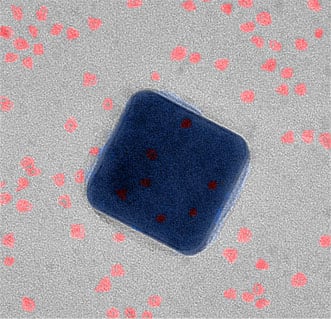DURHAM, N.C., July 27, 2015 — Able to flip on and off 90 billion times a second, a new plasmonic light emitter could form the basis of optical computing.
"This is something that the scientific community has wanted to do for a long time," said Duke University professor Maiken Mikkelsen, whose team developed the device. "We can now start to think about making fast-switching devices based on this research, so there's a lot of excitement about this demonstration."
The device consists of a 75-nm silver cube and a thin sheet of gold, with 6-nm quantum dots (QDs) sandwiched in between. Laser illumination generates plasmons on the cube's surface, which creates an intense electromagnetic field that triggers the QDs, producing directional, efficient emission of photons that can be turned on and off at a rate of more than 90 GHz.

Transmission electron microscope view of a superfast fluorescence system. The silver cube is 75 nm wide. The quantum dots (red) are sandwiched between the silver cube and a thin gold foil. Courtesy of Maiken Mikkelsen/Duke University.
"There is great interest in replacing lasers with LEDs for short-distance optical communication, but these ideas have always been limited by the slow emission rate of fluorescent materials, lack of efficiency and inability to direct the photons," said postdoctoral researcher Gleb Akselrod. "Now we have made an important step towards solving these problems."
"The eventual goal is to integrate our technology into a device that can be excited either optically or electrically," said Thang Hoang, also a postdoctoral researcher in Mikkelsen's laboratory. "That's something that I think everyone, including funding agencies, is pushing pretty hard for."
The group is now working to use the plasmonic structure to create a single-photon source — a necessity for extremely secure quantum communications — by sandwiching a single QD in the gap between the silver nanocube and gold foil. They are also trying to precisely place and orient the QDs to create the fastest fluorescence rates possible.
Aside from its potential technological impacts, the research demonstrates that well-known materials need not be limited by their intrinsic properties, the researchers said.
"By tailoring the environment around a material, like we've done here with semiconductors, we can create new designer materials with almost any optical properties we desire," Mikkelsen said. "And that's an emerging area that's fascinating to think about."
Funding came from the U.S. Air Force Office of Scientific Research, an Oak Ridge Associated University's Ralph E. Powe Junior Faculty Enhancement Award, the Lord Foundation of North Carolina and the Intelligence Community Postdoctoral Research Fellowship Program.
The research was published in Nature Communications (doi: 10.1038/ncomms8788).
For more information, visit www.duke.edu.